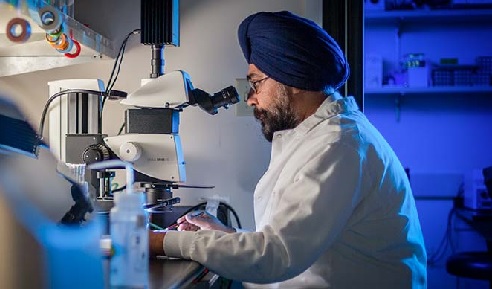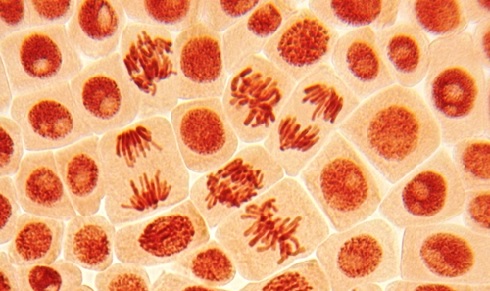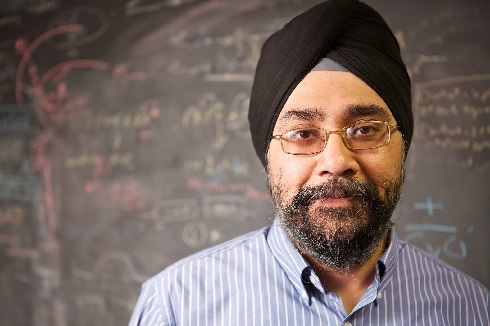Conflicting ideas
Harmit Malik talks to The Biologist about his influential work on genetic conflict – and how reconstructing virus–host arms races from deep in our evolutionary history could help us design new antiviral proteins
February 27th 2022
Earlier this year the Genetics Society of America awarded Professor Harmit Malik the Edward Novitski Prize, which recognises a ‘significant and exceptionally creative body of work to solve a difficult problem in genetics’. A professor and associate director at the Fred Hutchinson Cancer Research Center in Seattle, US, Malik studies the genetic conflicts that occur between and within organisms as different genetic entities compete to maximise their evolutionary success.
During his postdoctoral training Malik became interested in the question of why centromeres – key regions of DNA that help chromosomes separate during cell division – appeared to evolve rapidly, when one might expect such fundamental stretches of DNA to be highly conserved.
Using fruit flies (Drosophila melanogaster) as a study organism, he found that centromeres are locked in competition to increase their odds of transmission to the next generation during meiosis. Because these ‘cheating’ centromeres can cause skewed sex ratios or male sterility, centromeric proteins must also evolve rapidly to suppress the innovations in the ever-changing centromeres. The rapid genetic changes driven by this ‘centromere drive’ has since been shown to be a major factor in reproductive isolation between species.
Malik has also been instrumental in founding the field of ‘paleovirology’, the exploration of genetic changes that have occurred over millions of years from our ancestors’ battles with different viruses. Using ‘viral fossils’ – remnants of past infections imprinted in our DNA – Malik’s lab has been able to resurrect long-extinct viral and antiviral proteins from the evolutionary record. His work has helped us better understand why we are more susceptible than other primates to certain viruses and how our own innate antiviral proteins might be tweaked to offer better protection against contemporary viruses.
Hi, Harmit – firstly, congratulations on the Edward Novitski Prize. What does it mean to you?
I am completely humbled and I am actually a bit embarrassed given the people who have won this award before me. What really stands out with this prize is that it often celebrates work of a low-throughput nature. In our high-throughput world, I think there is a lot to be said for slow introspection – people doggedly solving puzzles by connecting many threads that other people have started. I actually picked up a thread that Edward Novitski himself started: the concept of meiotic drive really owes its roots to something he published in 1957.
You started your career as an engineer. How did you become interested in this very biological question about genetic conflict?
My dad was an engineer in the Indian Army and I joined one of India’s prestigious engineering schools to study chemical engineering. I was an average chemical engineering student. Then two things happened to me. One was running into a fantastic professor who was teaching a new course called ‘introduction to molecular biology’. That was the first time I’d really thought about molecular biology as an engineering problem. I was stunned by the absolute elegance, simplicity and power of that approach.
Around the same time I was in charge of buying cheap books on the streets of Bombay to fill our hostel library. One of the books was The Selfish Gene by Richard Dawkins. There are a lot of opinions about Dawkins the person, but Dawkins the writer is still such a phenomenal force. He painted this absolutely persuasive case about why selfishness should run rampant through biology. I got really excited about the idea and wanted to study it.
With just one class in biology, I scoped out schools in Europe and in the US, where people were more open to accepting someone with an engineering background onto a molecular biology PhD programme. I looked for people working on transposable elements, which was how I landed with Tom Eickbush at the University of Rochester, who was a pioneer of studying why these bits of DNA in our genome jump around and proliferate. Tom was one of the few people who were faculty on both the molecular biology and ecology and evolution tracks, so I started gravitating more and more to questions like: where do these elements come from? How are they successful? How does the genome manage the high cost that they bear? That was ultimately what my thesis became about.
 Image courtesy of fredhutch.org
Image courtesy of fredhutch.org
How did your theory of centromere drive develop?
I moved to Steve Henikoff’s laboratory in Seattle, and it was he who first showed me a phylogenetic tree of the diversity of centromeric proteins. They have these incredibly long branch lengths, which to the untrained eye is just noise. But given that I’d spent six years really studying phylogenies and transposable genetic elements I said: “That looks like this gene is under some conflict.”
Luckily I had read papers by Marcus Rhodes on maize from the 1950s and a more recent paper from Chuck Langley’s lab, which hypothesised that there may be competition going on in the egg to determine which chromosomes would be transmitted to the next generation. I remember very distinctly sitting in a Middle Eastern restaurant having dinner with Henikoff and his wife, Jorja. The restaurant owner came by and said they were closing, and we realised we had been talking about the possibilities of this for two and a half hours.
My idea was that centromeric DNA is rapidly evolving because each of these regions is actually acting selfishly, competing to be transferred to the next generation in the egg. However, there was still a gaping hole in the logic – it took us a long time to realise that the centromeric proteins are actually the things that curbed the selfishness. That was the breakthrough really – that the proteins were acting like an immune system to suppress the selfish centromeric DNA parasite. It was an almost heretical concept at the time because these two are completely essential components of the same process in the cell. That led to the idea that this conflict is completely fundamental in all manner of chromosome segregation, including mitosis and meiosis.
These things are evolving just as rapidly as an immune gene is, and that led us to think how different combinations from different species would not be compatible. So we began to think this could be one of the underlying principles that leads to biological reproductive isolation between species as well. That idea has now also had some nice validation both from my laboratory and from other labs as well. Again I think the story here is that there were already these ideas in the literature and if there is anything that I can claim, it was that I actually had read all these different papers even though they were not exactly in my field, and that really helped me lock in the pieces of the puzzle.
 Malik’s work has helped show that parts of our genome are competing to be passed on when cells divide or eggs form.
Malik’s work has helped show that parts of our genome are competing to be passed on when cells divide or eggs form.
Your work on genetic conflicts also involves looking at virus–host conflicts from the distant past and how these arms races have influenced our genomes over time. How do you go about finding and studying ‘fossil viruses’ in our genomes and what can they tell us?
The simplest way is to take existing viruses and look for similar DNA sequences in our genome. Retroviruses have to insert their DNA into the host genome to make daughter viruses and those imprints are a pretty reliable estimate [of what virus has previously infected the host]. Just like any other piece of the genome it’s subject to mutational abrasion over time, which means the longer it sits in the genome the more fossilised it’s going to get. But that’s actually a very good clock associated with each imprint. So not only do you get information about when the virus landed in the genome, but also how long it’s been there in terms of position and time.
If it’s a shallow period of evolution, we can completely resurrect intact pieces of these viruses. By taking different fossilised versions we can predict what the sequence of this virus would have looked like with a high degree of accuracy, basically reconstructing their common ancestor.
For example, in the human genome there’s an endogenous virus we refer to called Human endogenous retrovirus K (HERV-K), which was last really active about 600,000 years ago. There is no intact version of the virus anywhere in our genome, but there are several slightly imperfect versions. By just looking at each of their independent mutations that give rise to imperfections, we can reconstruct a fully intact and competent virus, which a couple of different laboratories have done. Now, whenever you do something like that, you do it with a lot of biosafety precautions – you don’t want to unleash the next epidemic. But it’s a powerful way for us to actually test our hypothesis about these arms races as well.
What can ancient viruses tell us in terms of strategies for combating pathogenic viruses today?
We have this really nice playbook as to what parts of our proteins can evolve rapidly and what parts of the protein can’t. So by focusing our attention on the parts of the protein that can evolve rapidly, we are now looking to come up with superior versions of these proteins against pathogenic viruses that we currently don’t have really good defences against. For good reasons molecular biologists have tended to be drawn to what parts of the protein have really stayed the same, from bacteria to humans. It’s the business end of the protein. What my work has really emphasised is that for genetic conflicts the parts of the protein that are the most rapidly evolving are the positions that we needed to be looking at.
A good example that’s ongoing in the lab is the influenza virus, where our best antiviral protection gives us maybe five- to seven-fold protection. Just by making a few changes at these key rapidly evolving positions they’ve been able to improve that to almost 100-fold.
We can currently do that in cells, but imagine if we could do that in a therapeutic sense for a pathogenic virus just like the one we are all currently facing. It would really provide a huge boost to the innate immune system of people while their adaptive immune system educates itself in how to expunge the virus.
What we can learn from the pieces of the viruses that have remained constant is where host genomes have actually stolen pieces of the viruses as decoys – effectively poisoning the virus by taking a piece of it and deploying it against itself. Although we are only just starting to build evidence, we believe that this has happened multiple times during evolution. There’s a remarkable example of an Ebola virus-derived gene fragment that is conserved in all bat species. That is potentially one of the main reasons why bat species might not be as susceptible to Ebola virus. This is a hypothetical at this point, but we are now trying to ask why bat species conserved this piece and whether it could be used as an antiviral.
By learning from all of these strategies we can use the same evolutionary principles to try to come up with novel strategies to combat viruses. It’s becoming very clear that we live in a day and age where pandemics are not going to be a one-off, so we really need as many creative ways to do this as possible.
Harmit Malik is a professor and associate director at the Fred Hutchinson Cancer Research Center. Through
the Malik Lab, he studies genetic conflict, the competition between genes and proteins with opposing functions that drives evolutionary change.

 Image courtesy of fredhutch.org
Image courtesy of fredhutch.org Malik’s work has helped show that parts of our genome are competing to be passed on when cells divide or eggs form.
Malik’s work has helped show that parts of our genome are competing to be passed on when cells divide or eggs form.

